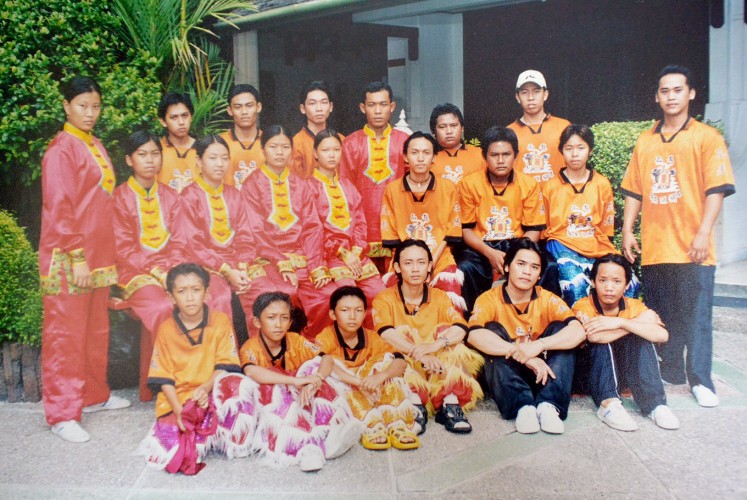Changing face of Barongsai
Barongsai Tripusaka is proof of Chinese acculturation in Indonesia, especially in Surakarta.
Change Size
 Young performer: Dumang, 9, one of the members of Barongsai Tripusaka, wears the head of a lion costume during the troupe’s training session in Surakarta, Central Java, on Feb. 9. (JP/Kusumasari Ayuningtyas)
Young performer: Dumang, 9, one of the members of Barongsai Tripusaka, wears the head of a lion costume during the troupe’s training session in Surakarta, Central Java, on Feb. 9. (JP/Kusumasari Ayuningtyas)
D
eni, 13, balanced on several poles agilely one afternoon. As one of about 60 members of Barongsai Tripusaka, the oldest lion-dance troupe in Surakarta, Central Java, he joined the group when he was only 7 years old. Now, his younger brother Dumang, 9, is also part of the team, which is dominated by performers of Javanese descent.
Epri Sunandar, 28, coordinator of Barongsai Tripusaka, said the number of Indonesians of Chinese descent joining the group was becoming smaller over the years compared to the growing Javanese membership. To date, there are less than 10 performers of Chinese descent out of the group’s 60 members.
Epri, a Javanese Muslim, has been active in Barongsai Tripusaka since he was 11. He was fascinated by barongsai dance movements and his determination to be engaged in the sport-art was supported by his parents from the beginning.
“My neighbors used to express their fear lest I might be influenced and change my faith, but I’ve remained a Muslim without being affected because this is only my hobby and sport,” Epri, who works as a driver, said.
Barongsai Tripusaka is proof of Chinese acculturation in Indonesia, especially in Surakarta. Following a ban on the activity by the New Order, Tripusaka initiated barongsai’s reappearance in the city as soon as the demise of the Soeharto regime in 1998.
“At first I just wanted to revive Wushu (martial arts) but later I decided to promote both as they’re interrelated,” troupe founder Aji Chandra said.
Aji said the group started with a membership comprising 50 percent Chinese and 50 percent Javanese performers. Today, there are eight barongsai clubs in Solo, each having 30 to 60 members.
“Ethnic Chinese barongsai players only constitute 10 percent of members at most, because of all the lion-dance clubs in Solo combined, Javanese members make up 97 percent and the rest are Indonesians of Chinese or Arab descent,” Aji said.

Chandra Halim, an observer of ethnic Chinese culture in Yogyakarta and Surakarta, said the Javanese domination of the barongsai tradition had begun since the inception of Presidential Instruction No. 14/1967, which prohibited Chinese customs and religions to be celebrated in public places.
The ban spread fear among ethnic Chinese who wanted to preserve the tradition. In an attempt to regenerate the ancestral practice, they invited the Javanese to participate. The Chinese New Year or Imlek has been openly celebrated after Abdurrahman “Gus Dur” Wahid issued Presidential Decree No. 6/2000, which lifted the ban on Chinese cultural expression.
“Normally, the ethnic Chinese [in Surakarta and Yogyakarta] who now take part in barongsai training sessions are those whose parents still adhere to their Chinese cultural traditions,” Halim said.
Aji also attributed the fact to barongsai’s Confucian or Buddhist image while most of Surakarta’s ethnic Chinese are now Christians.
“They’re afraid of being regarded as embracing Confucianism while in fact, barongsai is now more of an art and sport performance,” Aji said.
The Barongsai troupes in the city get many requests to perform a month ahead of the Chinese New Year, which will fall on Feb. 16. Last Sunday, Barongsaiand liong (dragon dance) troupes were among art and culture groups that enlivened Grebeg Sudiro, an event celebrating the fusion of Javanese and Chinese cultures that was attended by thousands of people in Surakarta.
While serving as the main staple of various art and cultural events leading to the Lunar New Year, barongsai is also a competitive sport at the National Sports Festival.
“We see barongsai as a form of art and sport rather than a ritual,” Epri said, adding that Barongsai Tripusaka has Muslim, Christian, Catholic, Buddhist and Hindu members besides Confucians.
Nova Felian, 31, one of the few ethnic Chinese barongsai players in the troupe, said he received full support from his family. For him, joining barongsai shows is also a hobby.
“It’s just like a sport for me, although my practice has often been hindered by my busy printing job,” he said.









